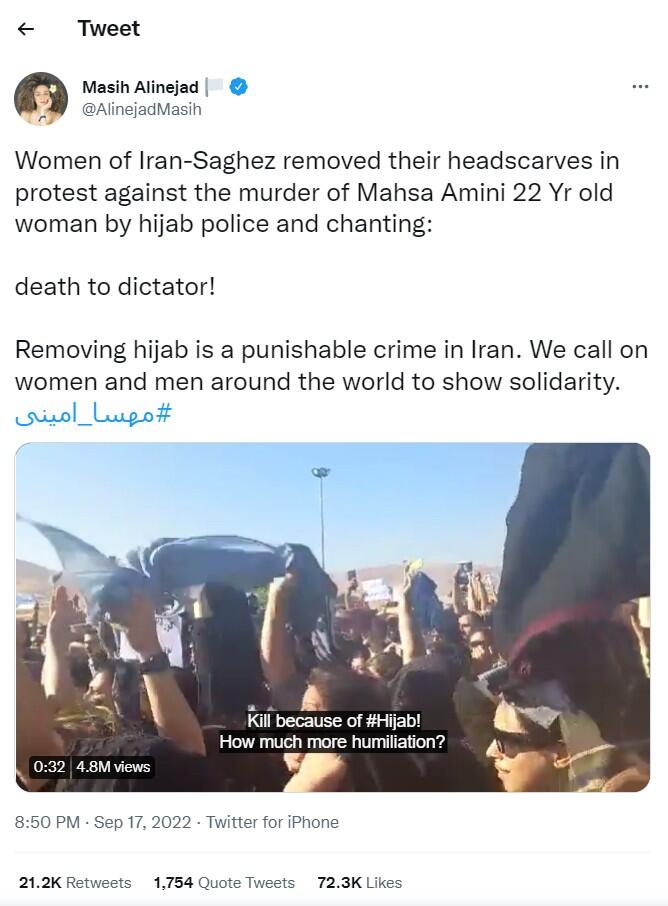- Beranda
- Komunitas
- News
- Berita Luar Negeri
Taking off their hijab: Iranian women’s protest against the headscarves
TS
groland
Taking off their hijab: Iranian women’s protest against the headscarves
 The custodial death of Mahsa Amini, a young woman who was arrested by the morality police in Tehran, has sparked widespread protests in Iran. Under the scanner are the police who patrol public places to enforce the headscarf law and other Islamic rules. Conversations are also taking place on the situation of women in the Islamic Republic.
The custodial death of Mahsa Amini, a young woman who was arrested by the morality police in Tehran, has sparked widespread protests in Iran. Under the scanner are the police who patrol public places to enforce the headscarf law and other Islamic rules. Conversations are also taking place on the situation of women in the Islamic Republic.Since the Islamic revolution in 1979, women have been required by law to wear a veil covering their head and neck and conceal their hair. Over the past two decades, however, more and more women in Tehran and other major cities of Iran have been letting strands of hair outside their veil as a form of protest. More recently, some women have been sharing photos that show them taking off headscarves in opposition to the hijab rules.
The struggle against compulsory headscarves first made headlines in December 2017 when a young woman, Vida Movahed, waved her hijab on a stick at Tehran’s Revolution Street. Then, on July 12, this year – the Hijab and Chastity Day on the Islamic Republic’s calendar — different groups of women took part in a national civil disobedience campaign against the mandatory headgear. More and more women, many of whom have not experienced the 1979 revolution, have been risking fines and even prison sentences for violating the hijab rules.
The Iranian Revolution, which ended with the victory of the Islamists and the creation of the Islamic Republic, was marked by a noticeable presence of women. Thousands of young women joined the Islamist and leftist political groups. In his interviews with foreign journalists before returning to Iran, Ayatollah Khomeini praised women for their involvement in the revolution.
Earlier, however, Khomeini had taken a firm stance against the Shah’s “White Revolution” — one of the axes of which was women’s access to the Iranian public space. Since the beginning of the 20th century, especially during the Constitutional Revolution of 1906-1911, avant-garde Iranian women demanded access to schooling and the right to expression. Before the end of Mohammad Reza Shah Pahlavi’s reign in 1978, 30 per cent of students in Iranian universities were women. Though many Iranian women were attracted by the revolutionary language of radical Islam in 1979, under the influence of religious intellectuals such as Ali Shariati, the country’s public space became a field of social and political confrontations between the sexes.
In March 1979, after the new Islamic law on veiling at workplaces came into force, massive demonstrations took place in the capital and major cities of Iran. Thousands of women took to the streets shouting slogans such as: “We did not make the revolution to go backwards.” The demonstrators were attacked and injured by Islamist stormtroopers. They were not supported by the secular opposition groups, who advised them to remain calm, so as to strengthen the anti-revolutionary forces and imperialists.
Along with the introduction of compulsory veiling, the Islamic Republic abolished the modernising reforms in the field of civil liberties for women and family law during the Pahlavi regime. The Shah-era laws restricting the exercise of polygamy and raising the legal age of marriage to 18 were abolished.
After the death of Khomeini in 1989 and the end of the eight-year war with Iraq, new ideological currents emerged among Islamist women who demanded reforms while supporting the Islamic regime. Reformist women stood firm against some of the ideological frameworks of the Islamic regime in the 1990s, but they were gradually overtaken in the first decade of the 21st century by a younger generation, the carriers of new demands.
The most significant action of this new generation of activists was the “One million signatures for the repeal of all discriminatory laws against women in Iran” campaign in 2006. From the Green Movement against electoral fraud in 2009 to the protests against acid attacks on women in the streets of Esfahan in 2014, women’s resistance movements have caused social and political tension in Iran.
In one of its recent reports on the country, Amnesty International noted that the Iranian authorities have not taken any initiatives to combat violence against women and girls in the private sphere or the public sphere. Recent history shows us that Iranian women have been present at all the major points in the country’s destiny. They have contributed to the evolution of the Iranian public sphere while building a new future for their country.
https://indianexpress.com/article/op...otest-8160322/
Wah Iran lg ribut
Diubah oleh groland 20-09-2022 14:55
tepsuzot dan 5 lainnya memberi reputasi
6
2.9K
22
Komentar yang asik ya
Urutan
Terbaru
Terlama
Komentar yang asik ya
Komunitas Pilihan